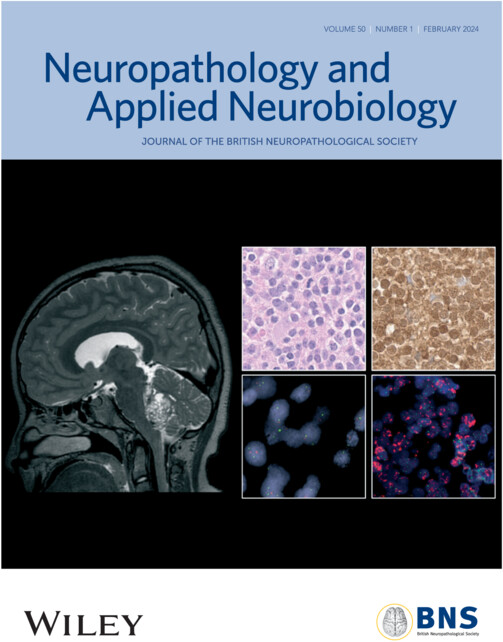Revisiting the relevance of Hirano bodies in neurodegenerative diseases
IF 4
2区 医学
Q1 CLINICAL NEUROLOGY
引用次数: 0
Abstract
AimsHirano bodies (HBs) are eosinophilic pathological structures with two morphological phenotypes commonly found in the hippocampal CA1 region in Alzheimer's disease (AD). This study evaluated the prevalence and distribution of HBs in AD and other neurodegenerative diseases.MethodsThis cross‐sectional study systematically evaluated HBs in a cohort of 193 cases with major neurodegenerative diseases, including AD (重新审视平野体在神经退行性疾病中的相关性
目的平野体(HBs)是一种嗜酸性病理结构,有两种形态表型,常见于阿尔茨海默病(AD)的海马CA1区。本研究评估了HBs在AD和其他神经退行性疾病中的患病率和分布情况。方法本横断面研究系统评估了193例主要神经退行性疾病病例中的HBs,包括AD(91例)、路易体病(LBD,87例)、进行性核上性麻痹(PSP,36例)、多系统萎缩(MSA,14例)和对照组(26例)。我们研究了裂隙层(HBL)和 CA1 锥体细胞层中 HB 的患病率、数量和形态。结果 CA1中的HB分为三种形态类型,包括一种新发现的类型,并分别进行了评估,从三个维度确认了它们的形态:(1) 经典杆状HB(CHB)、(2) 气球状HB(BHB)和新描述的(3) 弦状HB(SHB)。不同疾病组别中每种 HB 类型的发病率均有所不同:与对照组相比,CHB在AD、AD + LBD、PSP和皮质基底变性中,BHB在AD + LBD和PSP中,SHB在AD + LBD和PSP中均显著增加。回归分析表明,CHBs 与较高的 Braak NFT 分期独立相关,BHBs 与 LBD 和 TDP-43 病理相关,SHBs 与较高的 Braak NFT 分期、PSP 和霰粒肿相关,HBLs 与 MSA 相关。
本文章由计算机程序翻译,如有差异,请以英文原文为准。
求助全文
约1分钟内获得全文
求助全文
来源期刊
CiteScore
8.20
自引率
2.00%
发文量
87
审稿时长
6-12 weeks
期刊介绍:
Neuropathology and Applied Neurobiology is an international journal for the publication of original papers, both clinical and experimental, on problems and pathological processes in neuropathology and muscle disease. Established in 1974, this reputable and well respected journal is an international journal sponsored by the British Neuropathological Society, one of the world leading societies for Neuropathology, pioneering research and scientific endeavour with a global membership base. Additionally members of the British Neuropathological Society get 50% off the cost of print colour on acceptance of their article.

 求助内容:
求助内容: 应助结果提醒方式:
应助结果提醒方式:


